#Jeypore Portfolio of Architectural Details
Explore tagged Tumblr posts
Text

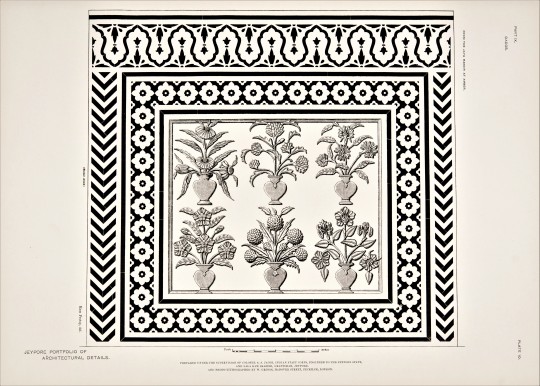
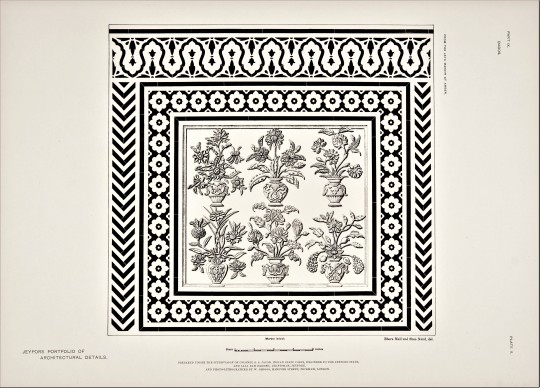
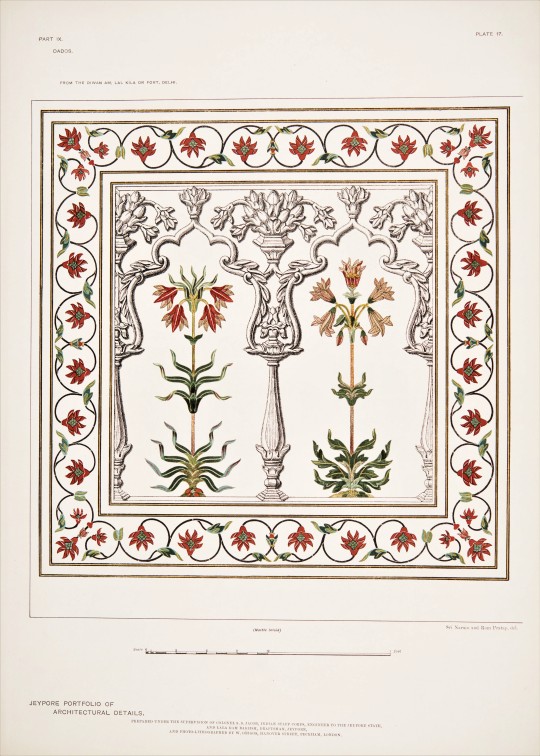
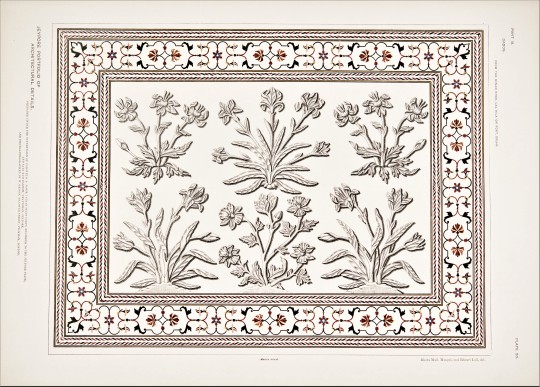


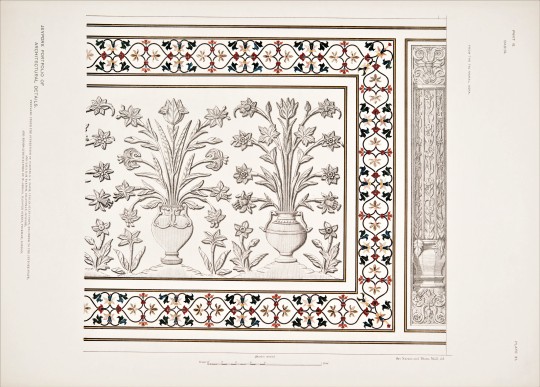
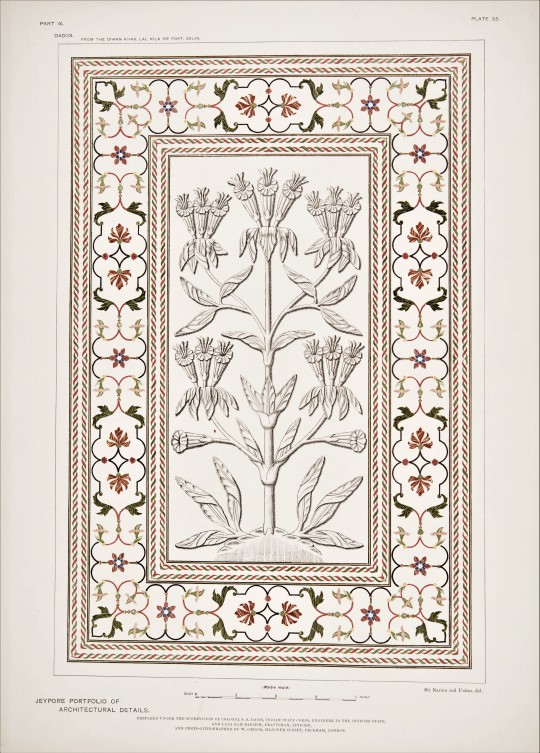

Decorative Sunday
This week we present some dados from volume 9 of the Jeypore Portfolio of Architectural Details, published in twelve volumes by Bernard Quaritch between 1890 and 1913. A dado is the lower part of a wall, below the dado rail and above the skirting board, that is often given over to decorative treatment.
Issued under the patronage of Maharaja Sawai Madhu Singh, the Jeypore Portfolio was prepared under the supervision of Colonel Samuel Swinton Jacob, Indian Staff Corps, Engineer to the Jeypore State, and Lala Ram Bakhsh, head draftsman and teacher in the Jeypore School of Art, and was photo-lithographed by William Griggs of London, the inventor of photo-chromo-lithography. The Portfolio was intended to serve as a record of the architectural heritage of the Jeypore State and the north-west region of Rajasthan. As a record, it would “rescue (such) designs from oblivion and give them new life.”
Of the 12-volume set we only hold volumes 7 (String and band patterns), 9 (Dados), and 10 (Parapets). These have been digitized and may be found in our digital collections.
View other posts from the Jeypore Portfolio.
View more Decorative Sunday posts.
#Decorative Sunday#decorative arts#decorative plates#Jeypore Portfolio#Jeypore Portfolio of Architectural Details#Indian architecture#architectural details#dados#Samuel Swinton Jacob#Lala Ram Bakhsh#Maharaja Sawai Madhu Singh#William Griggs#Bernard Quaritch#chromolithographs#yay chromoliths!#digital collections#lithographs#photolithographs#Indian design#Indian decorative arts
64 notes
·
View notes
Photo





Jeypore Portfolio Architectural Details Part III Carved Doors Prepared under the supervision of Colonel S.S. Jacob, C.I.E. Bombay staff corps: engineer to the Jeypore state. Assoc Institute of Civil Engineers. Hon Assoc Royal Institute of British Architects Issued under the patronage of His Highness Maharaja Sawai Madho Singh G.C.S.I. of Jeypore London: Bernard Quaritch. Photo-Lithographed by W. Griggs and Sons Limited, Hanover Street, Peckham. 1890 First of it's kind.
#first copy#Jeypore Portfolio#Sir Samuel Swinton Jacob#Architect#Patronage#Heritage#Lithograph#beaut#Beautiful#Jaipur#Jaipur Diaries#Jaipur Journal#Rajasthan#India#Incredible India#Wanderer#Wanderlust#Travel#Traveller#Traveler#TravelLog#Travelogue#Travel Diaries
14 notes
·
View notes
Photo



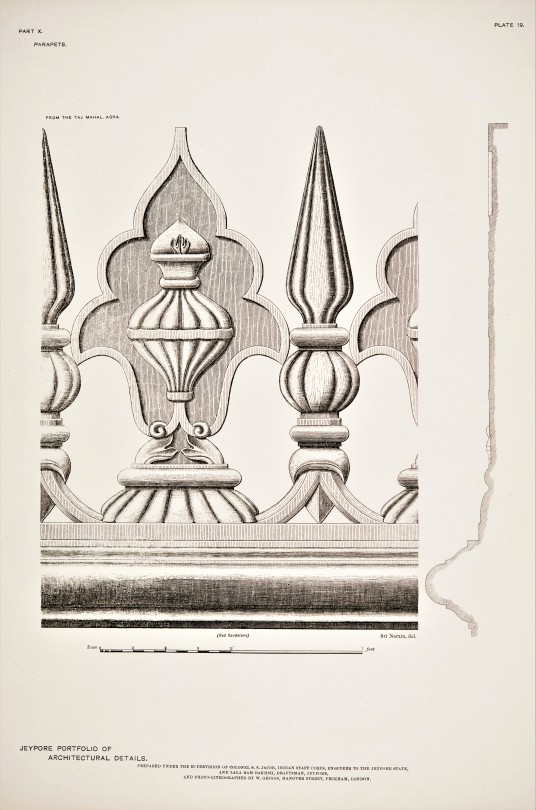

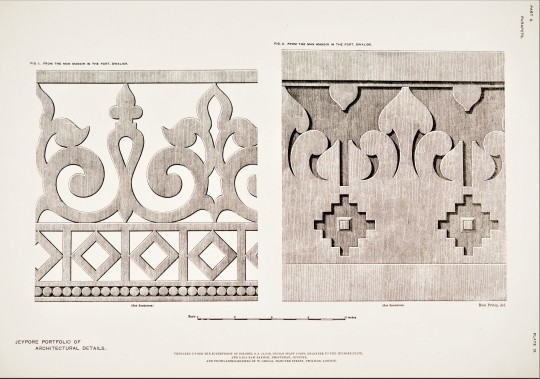

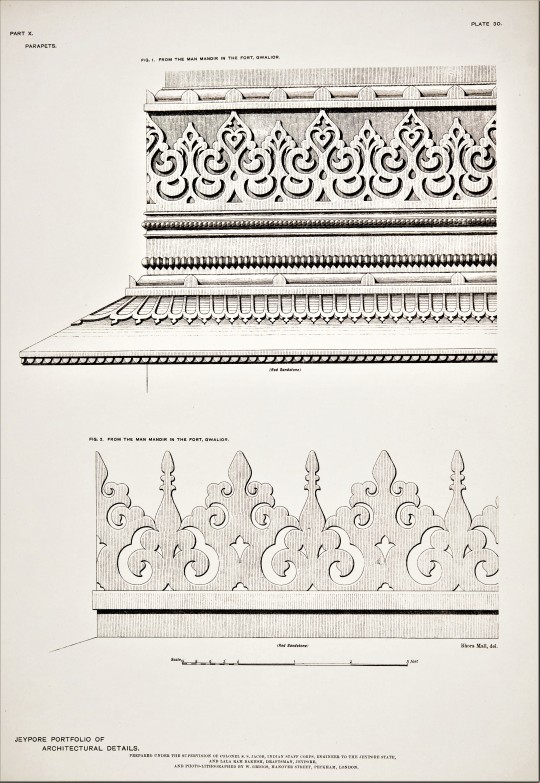
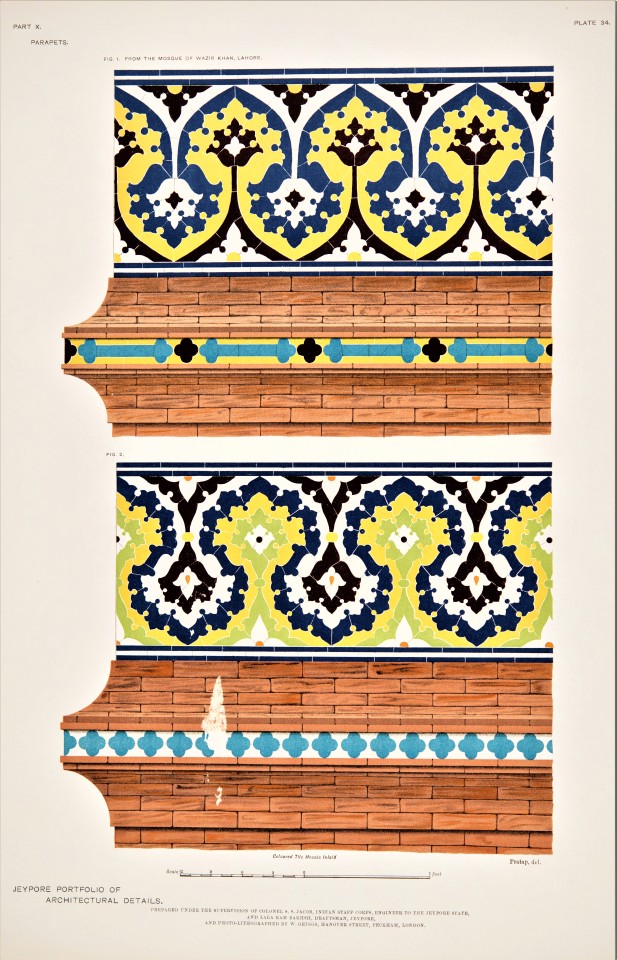
Decorative Sunday
This week we present some parapet designs from Jeypore Portfolio of Architectural Details, published in twelve volumes by Bernard Quaritch between 1890 and 1913. The plates displayed here are from volume 10 on parapets, the decorative extension of the wall at the edge of a roof, balcony, or other structure..
Issued under the patronage of Maharaja Sawai Madhu Singh, the set was prepared under the supervision of Colonel Samuel Swinton Jacob, Indian Staff Corps, Engineer to the Jeypore State, and Lala Ram Bakhsh, head draftsman and teacher in the Jeypore School of Art, and was photo-lithographed by William Griggs of London, the inventor of photo-chromo-lithography. The Portfolio was intended to serve as a record of the architectural heritage of the Jeypore State and the north-west region of Rajasthan. As a record, it would “rescue (such) designs from oblivion and give them new life.”
Of the 12-volume set we only hold volumes 7 (String and band patterns), 9 (Dados), and 10 (Parapets). These have been digitized and may be found in our digital collections.
View other posts from the Jeypore Portfolio.
View more Decorative Sunday posts.
#Decorative Sunday#decorative arts#decorative plates#Jeypore Portfolio#Jeypore Portfolio of Architectural Details#Maharaja Sawai Madhu Singh#Samuel Swinton Jacob#Lala Ram Bakhsh#William Griggs#indian architecture#Indian design#Indian decorative art#lithographs#photolithographs#chromolithographs#Yay chromoliths!#digital collections
66 notes
·
View notes
Photo










Jeypore Portfolio of Architectural Details
Today we are presenting decorative plates from Jeypore Portfolio of Architectural Details, published in twelve volumes by Bernard Quaritch between 1890 and 1913.
Issued under the patronage of Maharaja Sawai Madhu Singh, the set was prepared under the supervision of Colonel Samuel Swinton Jacob, Indian Staff Corps, Engineer to the Jeypore State, and Lala Ram Bakhsh, head draftsman and teacher in the Jeypore School of Art, and was photo-lithographed by William Griggs of London, the inventor of photo-chromo-lithography. The Portfolio was intended to serve as a record of the architectural heritage of the Jeypore State and the north-west region of Rajasthan. As a record, it would “rescue (such) designs from oblivion and give them new life.” The plates displayed here are from volume 9 on dados, the decorative treatment to the lower part of a wall.
View other posts from this title here.
View more posts about decorative arts and pattern books.
–Sarah, Special Collections Graduate Intern
#Jeypore Portfolio#Bernard Quaritch#Jeypore Portfolio of Architectural Details#Maharaja Sawai Madhu Singh#Samuel Swinton Jacob#Lala Ram Bakhsh#William Griggs#decorative plates#decorative arts#decorative art#ornament#pattern books#Indian art#indian architecture#dados#Sarah Finn#sarah
59 notes
·
View notes
Photo
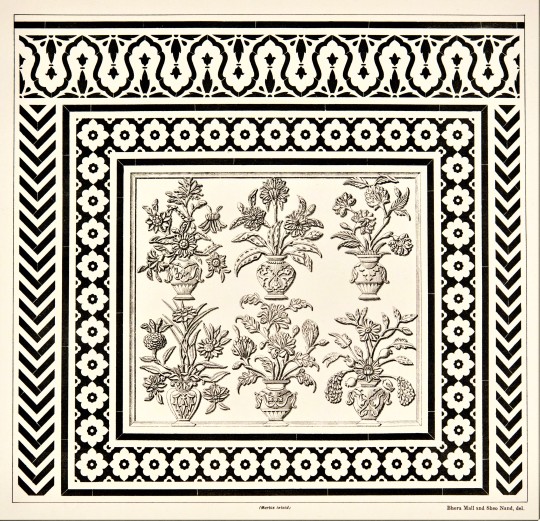
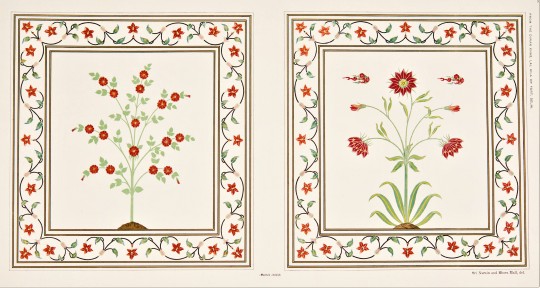

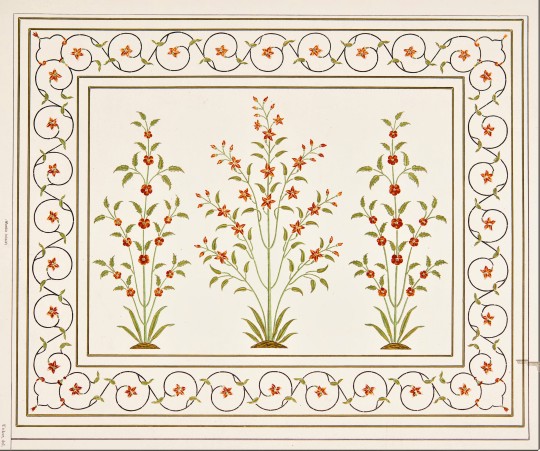
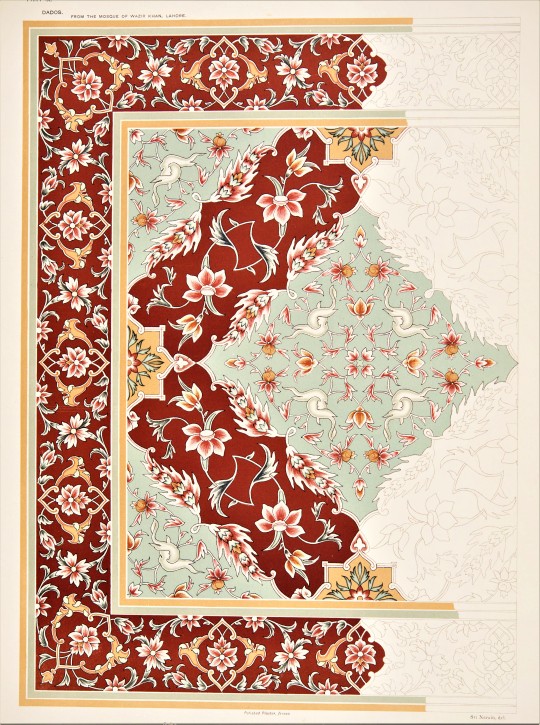
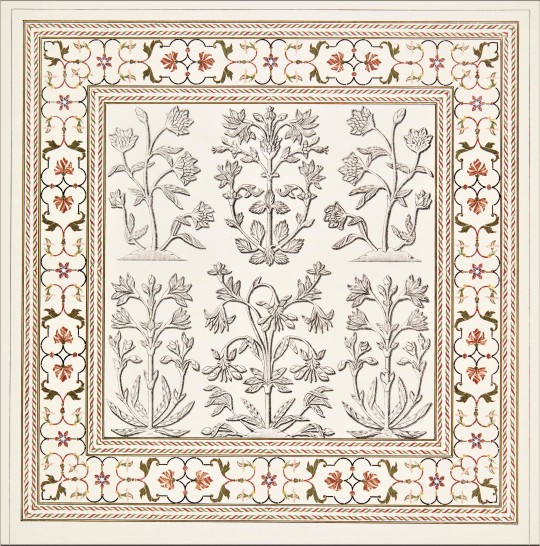
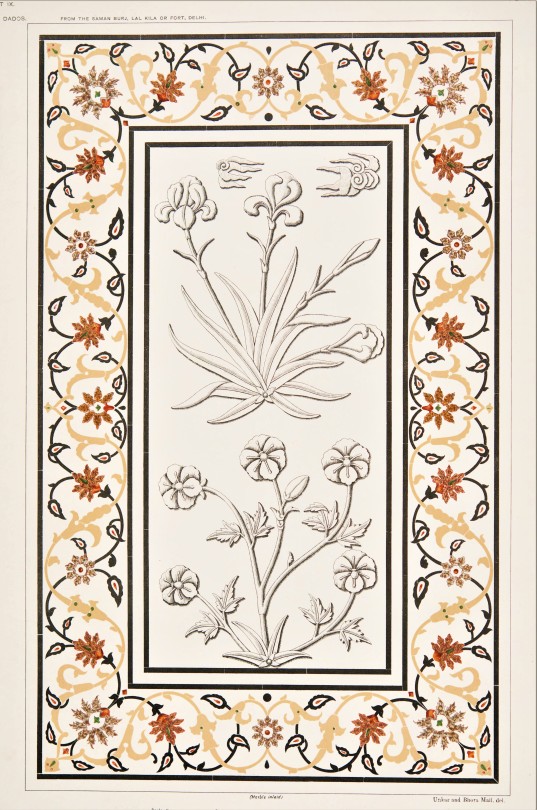

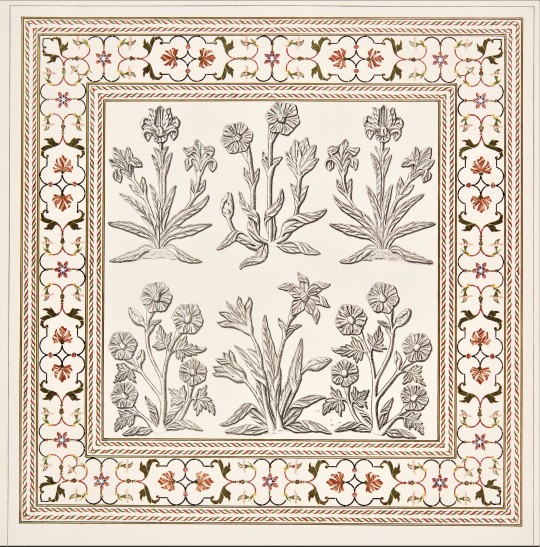
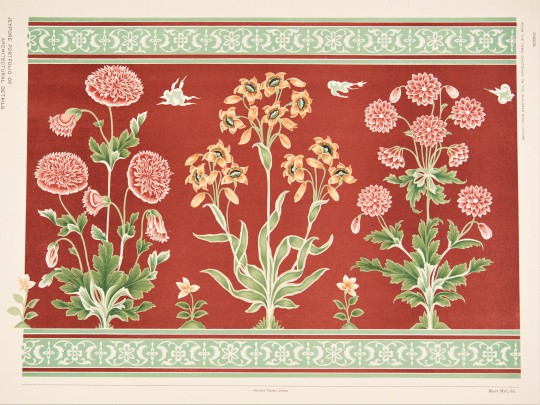
Dado Designs from the Jeypore Portfolio
This week we revisit the decorative plates from Jeypore Portfolio of Architectural Details, published in twelve volumes by Bernard Quaritch between 1890 and 1913. The plates displayed here are from volume 9 on dados, the decorative treatment to the lower part of a wall.
Issued under the patronage of Maharaja Sawai Madhu Singh, the set was prepared under the supervision of Colonel Samuel Swinton Jacob, Indian Staff Corps, Engineer to the Jeypore State, and Lala Ram Bakhsh, head draftsman and teacher in the Jeypore School of Art, and was photo-lithographed by William Griggs of London, the inventor of photo-chromo-lithography. The Portfolio was intended to serve as a record of the architectural heritage of the Jeypore State and the north-west region of Rajasthan. As a record, it would “rescue (such) designs from oblivion and give them new life.”
Of the 12-volume set we only hold volumes 7 (String and band patterns), 9 (Dados), and 10 (Parapets). These have been digitized and may be found in our digital collections.
View other posts from this title here.
View more posts about decorative arts and pattern books.
#Decorative Sunday#decorative plates#decorative arts#Jeypore Portfolio#pattern books#ornament#architecture#architectural design#Indian art#indian architecture#dados#Maharaja Sawai Madhu Singh#Samuel Swinton Jacob#Lala Ram Bakhsh#William Griggs#Bernard Quaritch#Jaipur#digital collections#lithographs#chromolithographs#Yay chromoliths!
112 notes
·
View notes
Photo










Parapet Designs from the Jeypore Portfolio
This week we return to the Jeypore Portfolio of Architectural Details, published in twelve volumes by Bernard Quaritch between 1890 and 1913. Shown here are a few parapet designs, the decorative treatment to the extension of the wall at the edge of a roof, from volume 10 in the set.
Issued under the patronage of Maharaja Sawai Madhu Singh, the set was prepared under the supervision of Colonel Samuel Swinton Jacob, Indian Staff Corps, Engineer to the Jeypore (Jaipur) State, and Lala Ram Bakhsh, head draftsman and teacher in the Jeypore School of Art, and was photo-lithographed by William Griggs of London, the inventor of photo-chromo-lithography. The Portfolio was intended to serve as a record of the architectural heritage of the Jaipur State and the north-west region of Rajasthan (not to be confused with the city of Jeypore in Odisha, India). As a record, it would “rescue (such) designs from oblivion and give them new life.”
Of the 12-volume set we only hold volumes 7 (String and band patterns), 9 (Dados), and 10 (Parapets). These have been digitized and may be found in our digital collections.
View other posts from this title here.
View more posts about decorative arts and pattern books.
#Decorative Sunday#decorative plates#decorative arts#Jeypore Portfolio#pattern books#ornament#Architecture#architectural design#Indian art#indian architecture#parapets#Samuel Swinton Jacob#Maharaja Sawai Madhu Singh#Bernard Quaritch#William Griggs#Lala Ram Bakhsh#Jaipur#digital collections#lithographs#chromolithographs#Yay chromoliths!
91 notes
·
View notes
Photo










Jeypore Portfolio of Architectural Details
Today we are presenting decorative plates from Jeypore Portfolio of Architectural Details, published in twelve volumes by Bernard Quaritch between 1890 and 1913.
Issued under the patronage of Maharaja Sawai Madhu Singh, the set was prepared under the supervision of Colonel Samuel Swinton Jacob, Indian Staff Corps, Engineer to the Jeypore State, and Lala Ram Bakhsh, head draftsman and teacher in the Jeypore School of Art, and was photo-lithographed by William Griggs of London, the inventor of photo-chromo-lithography. The Portfolio was intended to serve as a record of the architectural heritage of the Jeypore State and the north-west region of Rajasthan. As a record, it would “rescue (such) designs from oblivion and give them new life.” The plates displayed here are from volume 10 on parapets, the decorative treatment to the extension of the wall at the edge of a roof.
View other posts from this title here.
View more posts about decorative arts and pattern books.
–Sarah, Special Collections Graduate Intern
#Jeypore Portfolio#decorative plates#decorative arts#pattern books#ornament#Architecture#Bernard Quaritch#decorative art#Maharaja Sawai Madhu Singh#Samuel Swinton Jacob#Lala Ram Bakhsh#William Griggs#parapets#Indian art#indian architecture#Sarah Finn#sarah
79 notes
·
View notes
Photo










Piecing and Installing “Screen”
Last week we featured the process of putting together and installing the 16-foot long “Chandelier,” one of two handmade-paper installations created by Max Yela (Head, UWM Special Collections) and Dara Larson (art professor, Alverno College), with their assistants Cecilia Castro and Alison Newman, for the UWM Libraries’ Look Here! Project exhibition at Milwaukee’s Villa Terrace Decorative Arts Museum (June 28 - September 16).
Today we feature the second installation, “Screen.” The paper panels were formed on modified Japanese screens using cotton and abaca fibers, along with plant materials harvested from the grounds of the Villa Terrace Museum. The imagery was selected from materials in the distinctive collections at the UWM Libraries (Special Collections, Archives, Digital Collections, and American Geographical Society Collection) used by the other participating artists in the project. The imagery was made into stencils to create watermarks and paper-pulp prints by Dara, Max, Cecilia, and Alison; the paper panels for the screen were arranged by Max; Dara pieced all the panels together using PVA (Poly-vinyl Acetate); and the screen was installed by all four using a ring and dowel suspension system in the museum’s library with the assistance of Villa Terrace personnel. The 4.5′ x 5.7′ screen has paper-pulp prints on the outer edges and watermarked and plant-infused papers in the center on which will be projected digital imagery from UWM’s collections (not shown here).
We were so taken by the watermark imagery when we first held it up in front of windows at the Villa (shown here) that we decided to back-light the final installation. The imagery used in both installations are from:
Jeypore Portfolio of Architectural Details (1890-1913) from Special Collections, used by Nirmal Raja and Cynthia Hayes. The Grammar of Ornament (1868) from Special Collections, used by Melissa Wagner-Lawler. Our Native Birds of Song and Beauty (1893) from Special Collections, used by Jill Sebastian. Hand imagery from artist books in Special Collections, used by Lajwanti Waghray. Dog imagery from the John S. Best Collection in Special Collections, used by Stephanie Copoulos-Selle. Photograph collections (early 20th century) from UWM Archives, AGSL, and Digital Collections, used by Clayton Haggarty, Marc Tasman, and Anja Notanja Sieger. Plant materials from the Villa Terrace, referenced in the work of Rebecca Holderness and Andrew Miller.
View more posts about the Look Here! Project.
#Look Here! Project#papermaking#art installations#handmade paper#Villa Terrace Decorative Arts Museum#Max#Dara Larson#Cecilia Castro#Captain Alison#Max & Dara
17 notes
·
View notes